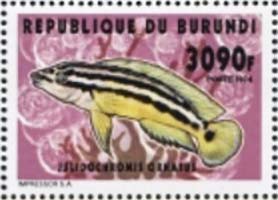Astatotilapia burtoni Günther, 1894

(de.wikiped
Phylum: Chordata Haeckel, 1874
Subphylum: Vertebrata Lamarck J-B., 1801
Classe: Actinopterygii Klein, 1885
Ordine: Perciformes Bleeker, 1859
Famiglia: Cichlidae Bonaparte, 1832
Genere: Astatotilapia Pellegrin , 1904
Descrizione
Il corpo è compresso lateralmente ed abbastanza allungato. Il dimorfismo sessuale è evidente soprattutto nelle dimensioni: il maschio può raggiungere 15 cm mentre le femmine in genere sono poco più lunghe di 7 cm. La pinna dorsale e la pinna anale sono allungate, mentre la colorazione ha prevalentemente tonalità blu con sfumature rosse sull'opercolo e sulle pinne. Sulla pinna anale sono presenti delle macchie circolari rossastre bordate di nero. Questi ciclidi sono ovipari e la fecondazione è esterna. Sono inoltre incubatori orali. A volte viene tenuto in acquario, ma è un pesce molto aggressivo.
Diffusione
Proviene dal lago Tanganica, nell'Africa orientale. Vive prevalentemente dove l'acqua scorre lenta e non è particolarmente profonda.
Sinonimi
= Chromis burtoni Günther, 1894 = Haplochromis burtoni Günther, 1894 = Tilapia burtoni Günther, 1894 = Tilapia nadinae Borodin, 1931.
Bibliografia
–Ntakimazi, G. (2018) [amended version of 2006 assessment]. "Astatotilapia burtoni". IUCN Red List of Threatened Species. 2018.
–Lang, Michael (2006). "A BAC Library of the East African Haplochromine Cichlid Fish Astatotilapia burtoni". Journal of Experimental Zoology. 306B (1): 35-44.
–Salzburger, Walter; Renn, Susan; Steinke, Dirk; Braasch, Ingo; Hofmann, Hans; Meyer, Axel (25 February 2008). "Annotation of expressed sequence tags for the East African cichlid fish Astatotilapia burtoni and evolutionary analyses of cichlid ORFs". BMC Genomics. 9 (96): 96.
–Parikh, Victoria N.; Clement, Tricia; Fernald, Russell D. (1 July 2006). "Physiological consequences of social descent: studies in Astatotilapia burtoni". Journal of Endocrinology. 190 (1): 183-190.
–Maruska, KP; Ung, US; Fernald, RD (18 May 2012). "The African Cichlid Fish Astatotilapia burtoni Uses Acoustic Communication for Reproduction: Sound Production, Hearing, and Behavioral Significance". PLOS ONE. 7 (5): e37612.
–White, SA; Nguyen, T; Fernald, RD (1 September 2002). "Social regulation of gonadotropin-releasing hormone". J Exp Biol. 205 (17): 2567-2581.
–Burmeister, SS; Fernald, RD (23 November 2004). "Evolutionary Conservation of the Egr-1 Immediate-Early Gene Response in a Teleost". The Journal of Comparative Neurology. 481 (2): 220-232.
–Blanchard, DC; Sakai, RR; McEwen, B; Weiss, SM; Blanchard, RJ (20 December 1993). "Subordination stress: Behavioral, brain, and neuroendocrine correlates". Behavioural Brain Research. 58 (1-2): 113-121.
–Young, EA; Abelson, James; Lightman, Stafford (2004). "Cortisol pulsatility and its role in stress regulation and health" (PDF). Frontiers in Neuroendocrinology. 25 (2): 69-76.
–Parikh, VN; Clement, VS; Fernald, RD (30 January 2006). "Androgen level and male social status in the African cichlid, Astatotilapia burtoni". Behavioural Brain Research. 166 (2): 291-295.
–Clement, TS; Grens, KE; Fernald, RD (21 July 2004). "Female affiliative preference depends on reproductive state in the African cichlid fish, Astatotilapia burtoni". Behavioral Ecology. 16 (1): 83-88.
–Juntti, Scott (2016). "A Neural Basis for Control of Cichlid Female Reproductive Behavior by Prostaglandin F2a". Current Biology. 26 (7): 943-949.
–Ichikawa, Michelle (2011). Maternal Mouthbrooding and Metabolism Regulation in "Astatotilapia Burtoni". Reed College.
–Butler, Julie M.; Maruska, Karen P. (2021). "Noise during mouthbrooding impairs maternal care behaviors and juvenile development and alters brain transcriptomes in the African cichlid fish Astatotilapia burtoni". Genes, Brain and Behavior. 20 (3): e12692.
–Grone, BP; Carpenter, RE; Lee, Malinda; Maruska, KP; Fernald, RD (26 April 2006). "Food deprivation explains effects of mouthbrooding on ovaries and steroid hormones, but not brain neuropeptide and receptor mRNAs, in an African cichlid fish". Horm. Behav. 62 (1): 18-26.
–0Butler, Julie M.; Maruska, Karen P. (1 June 2020). "Underwater noise impairs social communication during aggressive and reproductive encounters". Animal Behaviour. 164: 9-23.

|
Data: 15/01/2022
Emissione: Ittiofauna del lago Tanganica Stato: Burundi Nota: Emesso in un foglietto di 6 v. diversi |
|---|